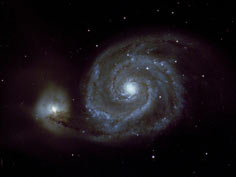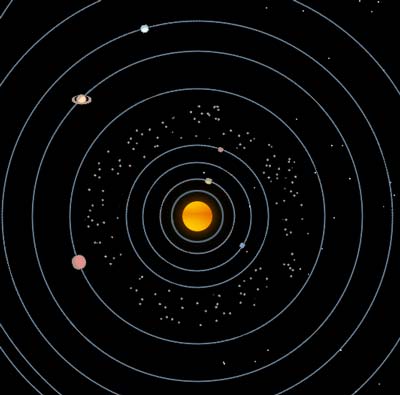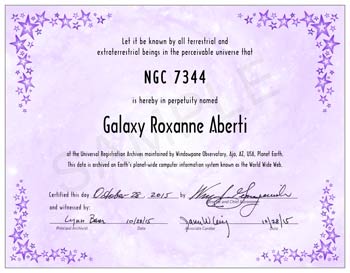Galaxy Registry Archive
To see the Galaxy Registry of Names, click here.
Windowpane Observatory has established on the World Wide Web a
registry of names for galaxies in the universe that were
previously unnamed. The vast majority of galaxies in the
perceivable universe have no names. Of course, for astronomers
this does not present a problem since physicists refer to
celestial objects by their astronomical catalog
number.

These numbers along with the celestial coordinates are then input into the targeting computer of the telescope and the instrument automatically slews to the object. For example, the most famous galaxy outside the Milky Way is the Andromeda Galaxy, named after the constellation Andromeda in which it is found. But astronomers refer to the Andromeda by it's catalog number. In the Messier Catalog of objects Andromeda's catalog number is M31. In the New General Astronomical Catalog Andromeda's catalog number is NGC 224.
So on the one hand, a heretofore unnamed galaxy will still
be referred to by astronomers by its number depending on what
catalog is employed. The naming of celestial objects does not change either their generic name nor their SAO number, NGC number, or other catalogue number. On the other hand, these anonymous
galaxies containing black holes, supernovae, open and globular
clusters and billions and billions of stars will now be named in this registry.
And because they are archived on the Internet's World Wide Web,
not only does anyone on Planet Earth have access to finding the
name of a certain galaxy, but also extra-terrestrials who are
able to go online could have access too! There are billions of
stars in each galaxy, and billions of galaxies waiting to be
named.
Navagating the Sky

The night sky is laid out in coordinates like latitude and longitude on Earth. The height of an object in the sky is measured in the degrees of Declination. The Celestial Equator is like our own equator on Earth. Objects above the Celestial Equator are indicated in +degrees and minutes. Those below in -degrees and minutes. The position of the fixed stars as the Earth revolves through its 24 hour cycle is divided into hours and minutes of Right Ascension. Thus, the position of an object in the sky never changes, but we can't see the same object because of the Earth spinning on its axis and the Earth spinning around the Sun.
Windowpane Observatory has started assigning names to
galaxies in the New General Catalog of Objects that are
heretofore unnamed. Because we are trying to raise
consciousness about astronomy and its application to the human
condition, we are registering galaxies in broad regions of the
sky demarcated by constellations. In this way, even if you do
not own a telescope or have access to an observatory you can
still find the region of the sky in which your galaxy is
located. You can point it out to others and lie under the night
sky contemplating what it means to have a celestial object as
vast and complex as our own Milky Way Galaxy named after you or
a loved one.
Galaxies are classified by types:
Elliptical Galaxies - There are elliptical shaped
galaxies which are signified by the abbreviation E. An E5
galaxy is more elliptical that an E1.
 Spiral Galaxies
- Most galaxies in the universe are spiral signified by the
abbreviation S followed by a lower case letter of the alphabet.
An Sa galaxy has more tightly wound spiral arms than a Sd
Galaxy.
Spiral Galaxies
- Most galaxies in the universe are spiral signified by the
abbreviation S followed by a lower case letter of the alphabet.
An Sa galaxy has more tightly wound spiral arms than a Sd
Galaxy.
Lenticular Galaxies - A lenticular galaxy is a galaxy
that appears lens-shaped. A lenticular galaxy is somewhere
between a spiral galaxy and an elliptical galaxy and is
signified by the abbreviation SO.
Barred Spirals - 30% of all spiral galaxies are barred.
Instead of the curved spiral arms starting from the nucleus of
the galaxy a bar of galactic material extends through the
center of the galaxy and the arms come off the bar. The
abbreviation SB signifies barred spirals. A SBa barred spiral
has more tightly wound arms than a SBd barred spiral
 See an animation of the movement of planets in our solar system.
See an animation of the movement of planets in our solar system. See amazing views from space
See amazing views from space

